CONCH SHELLS & CONCHUPISCENCE ON ABACO
Most conchs encountered in daily life are lying peacefully on the beach; or are artfully displayed; or are found in conch heaps (often in the vicinity of restaurants) like the ones below at Sandy Point. 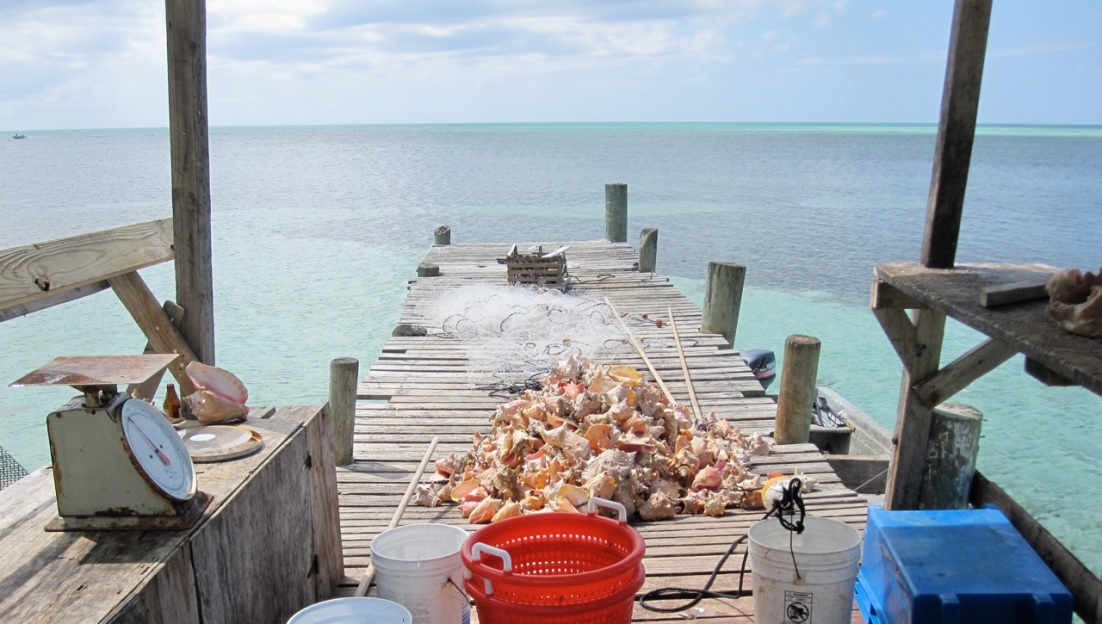

These shells at Sandy Point are so plentiful that they form a small spit of ‘land’ into the sea
An attractive display of conch shells in Marsh Harbour
A less formal arrangement along the jetty at Man o’ War Cay (after a storm)
It’s easy to forget that these shells are more than just a garden adornment, or pretty containers for a ubiquitous Caribbean food. Under the sea, and not very far at that, are living creatures going about their daily lives.

And that includes reproducing. This sounds as if it might be a cumbersome process, but (like porcupines) they seem to manage. Here is a pair preparing to mate. The male behind is presumably about to… well never mind. I’ve never seen the process, so it’s a case of using imagination. Or just accepting that, whatever it is that they do, it works. [I haven’t located a video online – I’ll post one if I do]
You’ll find some more about Conchs in a previous post HERE, including 12 Unputdownable Conch Facts, notes on conservation matters and… a photo of Honeychile Rider, arguably the most famous conch-carrier ever. Oh, she was fictional, you say? But I always though she… How very disappointing.
And if you want to know how to clean a conch, a dude will show you in a video on this page HERE
Finally, check out the very informative website COMMUNITY CONCH, a charitable conservation organisation 
Photo credits: Melinda, Clare, RH
POST BEAUTY & THE BEACH: A CLOSE LOOK AT SOME ABACO SHELLS
KING HELMET SHELLS (Cassis tuberosa) FROM THE DELPHI COLLECTION
It’s time to look at another shell from Delphi. The club has glass jars displaying small shells in the Great Room. Larger shells like the ones below are displayed on shelves. The King Helmet is the largest of the helmet shells of the family Cassidae. They are found in the Western Atlantic from North Carolina through the Caribbean and the gulf of Mexico down to Brazil. They tend to bury themselves during the day, becoming active and feeding at night. In humans this behaviour is found mainly in students and in those involved in the music business and similar louche occupations.

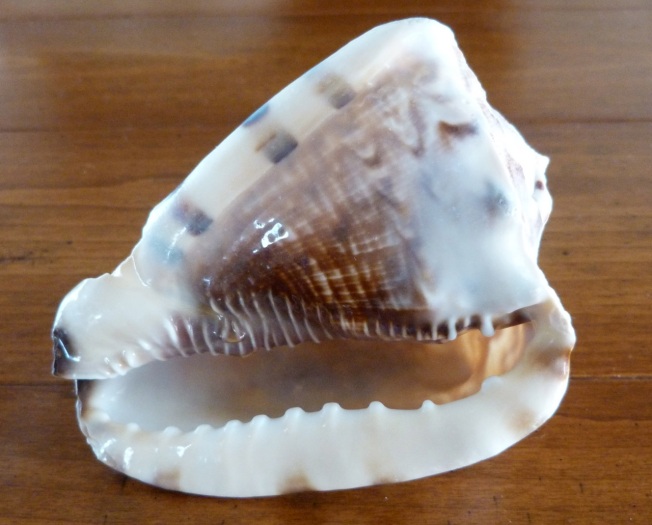
King Helmets prey mainly on sea urchins and other echinoderms, using their foot to grip their meal. The dining arrangements are somewhat protracted. The snail makes a hole in the urchin through the combined action of a glandular secretion which is rich in sulphuric acid, while using its RADULA to rasp and dig through the shell to get at the trapped occupant, which it gradually consumes… That’s enough about that.
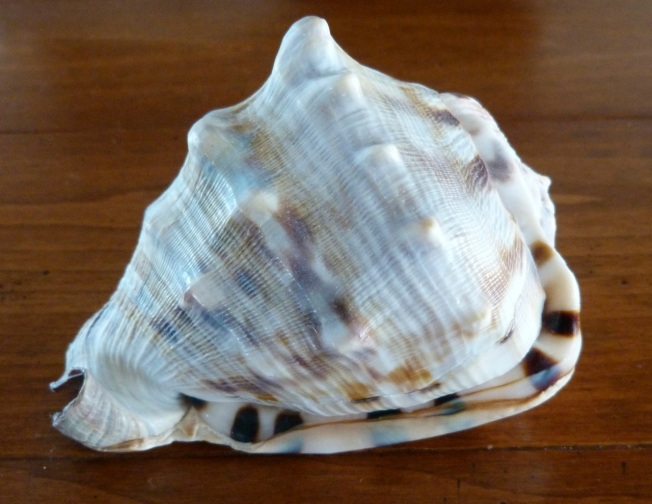
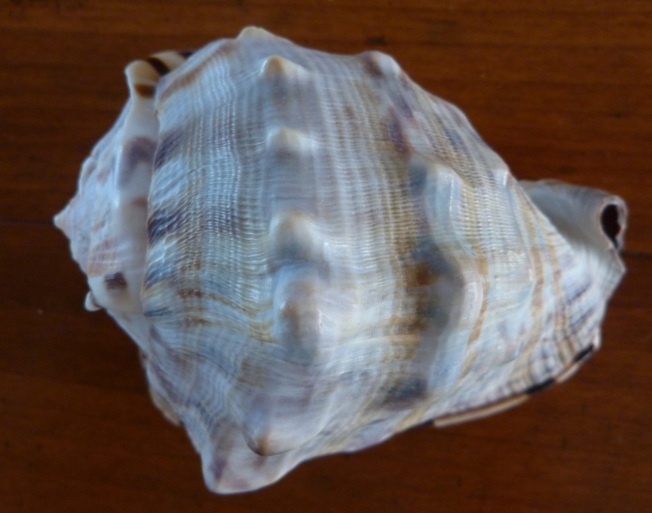
FLAMINGO TONGUE SNAILS & SHELLS: COLOURFUL GASTROPODS OF THE CARIBBEAN
FOR AN UPDATED POST ABOUT FLAMINGO TONGUES WITH MORE PICS AND INFO CLICK HERE
The FLAMINGO TONGUE SNAIL Cyphoma gibbosum is a small sea snail (marine gastropod mollusc), related to cowries. The live animal is brightly coloured and strikingly patterned, but that colour is only in the ‘live’ parts – the shell itself is pale and characterised by a thick ridge round the middle. These snails live in the tropical waters of the Caribbean and wider western Atlantic. Whether alive or dead, they are easy to identify.
This snail on the left (thanks, Wiki) is snacking on a coral stem, leaving a feeding track behind it. The structural shell ridge is clearly visible beneath the distinctively marked live tissue.
The flamingo tongue feeds by browsing on soft corals. Adult females attach eggs to coral which they have recently fed upon. About 10 days later, the larvae hatch. They eventually settle onto other gorgonian corals such as Sea Fans. Juveniles tend to live on the underside of coral branches, while adults are far more visible and mobile. Where the snail leaves a feeding scar, the corals can regrow the polyps, and therefore predation by C. gibbosum is generally not harmful to the coral.![Cyphoma gibbosum on Sea Fan [Cheers, Wiki]](https://rollingharbour.files.wordpress.com/2012/11/220px-cyphoma_gibbosum_0011.jpg?w=220&h=147)
The principal purpose of the mantle of tissue over the shell is as the creature’s breathing apparatus. The tissue absorbs oxygen and releases carbon dioxide. As I have seen it described (unkindly?) “it’s basically their lungs, stretched out over their rather boring-looking shell”.
This species was once common but is becoming rarer. One significant threat comes from snorkelers and divers who mistakenly think that the colour is the shell of the animal, collect up a whole bunch, and in due course are left with… (see photos below)
These photos are of flamingo tongue shells from the DELPHI CLUB COLLECTION. Until I read the ‘boring-looking shell’ comment, I thought everyone thought they were rather lovely… you decide!
Finally, a couple of videos. The first is rather charmingly titled ‘FLAMINGO TONGUES DOING…. SOMETHING’. Any (printable but amusing) suggestions via the Comment box are welcome (Hi Trish!). The second punchily summarises this post. Maybe that’s all that was needed!
ABACO SHELLS: 3 MORE FROM THE DELPHI CLUB COLLECTION
I have recently featured some of the shells from the collection amassed at Delphi – see SHELLS 1 and SHELLS 2. They are kept in vases or bowls for display and examination. They may not all come from the immediate vicinity, but they are all, for sure, from South Abaco. It’s time for some more.
A vignette of RH examining shells on the balcony at Delphi
TULIP SHELLS & SUNRISE TELLINS: MORE SHELL TREASURES FROM ABACO
Here are two contrasting shells from the Delphi Club collection that has been haphazardly accumulated over the last 3 years or so. The first post in this shell series was about SEA URCHINS & SEA BISCUITS
TULIP SHELLS Fasciolaria tulipa

The term ‘Tulip snail’ includes 3 related species of sub-tropical gastropod worldwide, of the genus Fasciolaria. They are medium-sized predatory molluscs that breed throughout the year in warm waters. Their reproductive lives deserve some attention, if they will pardon the intrusion. 
Research by the Smithsonian Marine Station Fl. reveals that the male’s penis is to be found on the right side of its body, directly behind its head… When they mate the (larger) female stays in an upright position on the sand while the male ‘flips over’ to align the apertures of both shells, before inserting the penis into the female (RH comment: the research is not specific about precisely where the female keeps her own genitals). Once joined, snail pairs may remain locked together for up to 2 hours, even when being watched by researchers. They have plenty of stamina: mating may occur several times in one season, and individual tulip snails have been observed to mate up to 3 times in a single week. Respect!

SUNRISE TELLINS Tellina Radiata
I included these pretty shells, with their striking pink radials, in an earlier post BEACHCOMBING BIVALVES The ones shown here are larger specimens. The hinges (muscles) are very delicate, and in these shells the two halves of the shells have separated. STs are not uncommon, but these are the largest I have come across (I realised after I had taken the photos that I should have used a coin for comparison…). They grow up to about 7 cms, and these ones were that length, or very nearly so.
I can’t assist with their sex lives I’m afraid, which may well be completely conventional, dull even. However, as I discovered when I previously researched these shells, “in most countries it is illegal to bring back these shells from holidays”. To which I can only repeat my comment: Whoops!
SEA URCHINS & SEA BISCUITS – BEACHCOMBING TREASURES ON ABACO
It’s time we had some more shells and other beach treasures on these pages. In the absence of star Abaco beachcomber and blog-contributor KASIA I have taken a closer look at the Delphi Club collection. This has been casually accumulated by the Club, its members and guests during the past 3 years whenever a good specimen has been encountered, and is displayed in the Great Room. The first items to catch my eye were the ECHINODERMS, a family that includes sea urchins, sand dollars, sea biscuits and star fish. Their sun-bleached tests are often found, though in my limited experience the larger they are, the rarer. The link above is to the Wiki-blurb, which has the unpromisingly daunting heading “This article may be too technical for most readers to understand…”. Now there’s a challenge!
First up is a very large SEA URCHIN, a thing of great delicacy and fragility that weighs next to nothing. I have never seen a bigger one. Looking at the fine detail, it is hard to believe that such perfection of symmetry and intricacy can exist in a creature so very painful to tread on.
This SEA URCHIN is smaller, with more prominent nodules and a much more random pattern – reminiscent of a cartoon of some distant white planet. It has cast a fine knobbly shadow.
SEA BISCUITS have similar five-way symmetry to their first cousins SAND DOLLARS but are generally pebble-shaped rather than disc-shaped. I have included 2 close-ups to show the fine details of the pattern – almost like lace-work



This SEA BISCUIT is a different type, with the 5 radials reaching right round it. For some reason it only has 4 and not 5 small holes (as one might expect) at the centre. Unlike SAND DOLLARS they tend to be more oblong than round.
 A RANDOM ABACO SHELL FROM THE BACK OF A DRAWER
A RANDOM ABACO SHELL FROM THE BACK OF A DRAWER
We recently discovered this shell loitering at the back of a drawer. It may well have been there for a couple of years… I had no idea what species of gastropod it might be, so I turned to a book I recently bought (and am about to review), the Peterson Field Guide on Shells. It is extremely thorough and well-illustrated, and almost at once I was able to pick the shell out as a STOCKY CERITH Cerithium Litteratum (Colin – are you still keeping an eye on the shell ID errors in this blog, I wonder?). It’s a couple of inches long and has 7 spirals before the tip part, with pronounced nobbles on the lowest 4. There’s a neat hole in it, but I don’t know whether caused by sea / beach damage or a predator. These creatures live in shallow water and are common throughout the Caribbean. So this one is nothing unusual, but I am pleased that it has eventually turned up…
STOCKY CERITH Cerithium Litteratum
 CONCH CENTRAL AT SANDY POINT, ABACO
CONCH CENTRAL AT SANDY POINT, ABACO
The serious conch action in Sandy Point is to be found at the jetty. I learned a simple beginner’s lesson on our first visit to Abaco. If you choose a large gorgeous-hued conch from the huge pile in the 4th photo to take back home, it will quickly start to smell dodgy, followed by evil… until you clean it properly!

KING VENUS CLAM Verenidae – Chione Paphia
These bivalve molluscs seem to be inoffensive, and to lead rather dull lives: so far all I have discovered is that “they live buried in sand at depths of 1 – 20 fathoms” I shall investigate further & report back – there must be some small creature they molest or upset in some way…
KASIA’S MYSTERY ABACO SHELL: A PUZZLE FOR XMAS
Kasia’s beachcombing exploits have produced some lovely seashells that have already featured here. Precise identification has sometimes been difficult for an amateur, because of the many varieties of a particular type of shell or close resemblance to other shell families. This one has got me stumped. I have trawled the internet. I have studied field guides. I’m still baffled. It hasn’t quite matched any other shell…
XMAS PRIZE the first person to ID this shell correctly will enjoy a bottle of ice-cold Kalik being drunk on the Delphi balcony swing in February 2012. By me. Suggestions to rollingharbour.delphi@gmail.com welcome
STOP PRESS: NOW SOLVED – SEE UNDER IMAGES

 Helpful thoughts: I’ve considered a form of King’s Crown (but I’ve not found a close enough match) or a Ram’s Horn Snail (but they don’t seem to have spines)
Helpful thoughts: I’ve considered a form of King’s Crown (but I’ve not found a close enough match) or a Ram’s Horn Snail (but they don’t seem to have spines)
First entry by Kasia (potentially disqualified as the shell’s owner): Angaria, a form of Turban shell. However these seem to be confined to Pacific areas…
THE SOLUTION: And the winner (within 24 hours) is… Kasia!
I sent the link to the post to Bahamian seashell expert Colin Redfern at http://www.bahamianseashells.com, author of ‘Bahamian Seashells: 1000 Species from Abaco, Bahamas’. He confirms Kasia’s ID as an ANGARIA SHELL , one of a large number of species of turban shells TURBINIDAE found throughout the world. It is indeed a Pacific shell, probably from the Philippines. So what on earth was it doing on a beach on the east coast of Abaco? Colin has encountered this sort of anomaly before, and gives various possible explanations:
1. Homeowners’ shell collections come from areas other than the Bahamas & are sometimes thrown out onto a beach. They may be washed up along the coast
2. Shops sell packets of shells, including Pacific shells, which may become dispersed
3. In Fl. it is not unknown for resorts to “seed the beach” with Pacific shells, which are cheaper & more easily bulk-bought than Atlantic shells
4. Rare Pacific & Indian Ocean shells washed up on a beach were once traced to the owner, whose beach house had been lost in a hurricane some years before
Many thanks, Colin, for your help with this puzzle; and congratulations Kasia – I’ll claim my Kalik in February please. Oh I see, I’ve got to buy you one, have I?
MUREX (MURICIDAE) & TRITONS (RANELLIDAE)
1. MUREX SHELLS (Muricidae)
This is a vast family of shells worldwide, with many subspecies, each of which has many regional variations. Or even variations of the same subspecies on the same beach. 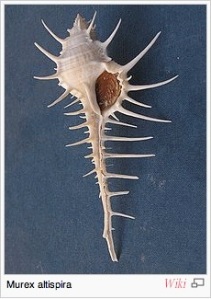 Many have beautiful delicate spines or intricate shapes and elaborate patterns, like the pacific one shown
Many have beautiful delicate spines or intricate shapes and elaborate patterns, like the pacific one shown
These molluscs are described as ‘voracious rock scavengers’ and exhibit uninhibited psychopathic tendencies. If you have a nervous disposition, stop reading here; Sam Peckinpah missed a great film collaboration with Jacques Cousteau with these vicious little creatures
10 ESSENTIAL YET GRISLY MUREX FACTS
- Murex are highly carnivorous with rasping teeth, and drilling equipment for boring into the shells of their prey
- A determined Murex may take up to 5 days to drill into its prey
- Murex also use their foot to smother prey, or to crush it by using suction power
- They eat clams by hoovering them up with their foot and smashing them on rocks to get at the occupant
- They happily eat sea-floor carrion and sea-kill
- Murex act in packs to carry out raids on unsuspecting beds of clams, which they feast on avidly
- They are sexually wanton. Females store sperm from different males for many months, eventually producing embryos with different dads (I’m not making this up. I would like to have done so)
- Cannibalism occurs. The kids are equally prone to extreme delinquency and are happy to eat each other when peckish
- Some species of murex secrete a fluid that is believed to be used to drug their prey into paralysis
- That same fluid (Murex / Mucus) is also used as a dye, ‘Tyrian’ or ‘Royal’ Purple, which can be ‘milked’ from a living murex (the Aztecs & Phoenicians did this). I’ll pass on that
NEW: VIDEO of how to obtain dye from a Murex
2. TRITON SHELLS (RANELLIDAE)
KASIA’S TRITON TROPHY FROM CASUARINA, ABACO
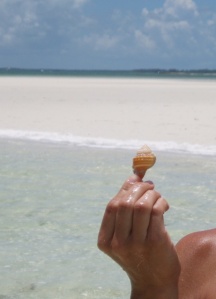 Here is another shell from Kasia’s beachcombing in the Casuarina Point area on Abaco. I’ve never seen one like this. I thought it was a TROPHON, a variety of the huge MUREX family. As I wrote, there are more than 30 types of trophon world-wide, many with a similar configuration, though I hadn’t managed to find one with a similar colouring and shell growth-pattern yet. I invited confirmation or correction, which Colin Redfern kindly provided. It is in fact a fine example of a…
Here is another shell from Kasia’s beachcombing in the Casuarina Point area on Abaco. I’ve never seen one like this. I thought it was a TROPHON, a variety of the huge MUREX family. As I wrote, there are more than 30 types of trophon world-wide, many with a similar configuration, though I hadn’t managed to find one with a similar colouring and shell growth-pattern yet. I invited confirmation or correction, which Colin Redfern kindly provided. It is in fact a fine example of a…
DOG-HEAD TRITON Cymatium cynocephalum
ANGULAR TRITON Cymatium femorale – A different sort of triton found by Kasia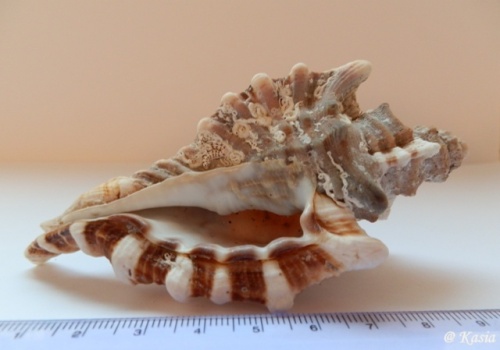
 SHELLS FROM KASIA’S BEACHCOMBING COLLECTION
SHELLS FROM KASIA’S BEACHCOMBING COLLECTION
COWRIES AND PHALIUM
1. RETICULATED COWRIE-HELMET Cypraecassis testiculus Here is a pretty example of this shell, a relative of the large phalium family and originally misidentified by me as a Phalium granulatum
2. MEASLED COWRIE Macrocypraea zebra / Cypraea zebra Colin Redfern says of this example “Immature shells have transverse stripes that are later covered by a spotted layer (hence “measled”). It looks as if it’s beachworn rather than immature, so the outer layer has probably been worn away. You can see remnants of the spotted layer adjacent to the aperture.” 


STOP PRESS: by coincidence, while looking for a completely different type of shell online I have just happened upon this early 1800s engraving of a Cypraea Vespa, which is very similar to Kasia’s one
ABACO SHELL SKELETONS
Besides ‘living shells’ with occupants in residence and shiny recently-vacated shells, there is a third category of shell: the skeleton. I am sure there’s a better or more technical word for these. They aren’t fossils in the strict sense of remnants from a past geological age, but merely worn by the waves and bleached by the sun over time. Here are two examples (from different beaches) which show the intricacy of the part of the shell you don’t normally see: the interior
A shell skeleton from Little Harbour, in situ on the beach on a cloudy day
The same shell washed, with a wonderful pink tinge in sunlight

A strange corkscrew skeleton shell from Sandy Point. I’ve no idea what it is, nor how any creature can have lived in or around it, nor what it must have looked like when complete. Any ideas? Please use the comment box Thanks, Kasia, for your ID of both as conch skeletons. The first obviously is but the second puzzled me… until she pointed out that conchs build their own shells round themselves to their own designs rather than go to the one-stop conch shell shop. So if a conch starts wrapping itself comfortably round its own corkscrew, this is what you get
 (Mrs rh quite rightly points out that my shell photos are unhelpful without a ruler to give an idea of size. Point taken. Too late. These are medium size…)
(Mrs rh quite rightly points out that my shell photos are unhelpful without a ruler to give an idea of size. Point taken. Too late. These are medium size…)
 CASSIS SHELLS (PHALIUM)
CASSIS SHELLS (PHALIUM)
1. SCOTCH BONNETS (or ‘ridged bonnets’)
Semicassis granulata or Phalium granulatum are a medium-sized species of sea snail found in the tropical and subtropical western Atlantic from North Carolina to Uruguay. They are predators, foraging on sandy stretches of the ocean floor for echinoderms such as sand dollars, sea biscuits, and sea urchins (Caution: ‘Oxford comma’)
- It takes approximately six years for a Scotch bonnet to mature
- The shells grows 2 – 4 ins long (5 – 10 cm), showing distinct growth stages
- Scotch bonnets live on sand, usually in fairly shallow water (but see below)
- The more a Scotch bonnet eats the more elaborate its shell, the glossier its sheen & the brighter its colours (research suggests this doesn’t work for humans)
- Divers frequently find Scotch bonnets at depths of 50 – 150 feet (15 to 46 m). Specimens have been found in depths up to 308 ft (94 m)
- Shipwrecks provide a good habitat for this species
- Crabs are its main predators, crushing the shell to get at the occupant. Since the snails’ main defence mechanism is to withdraw into their shells, they urgently need to evolve a new tactic
- The empty shell of this sea species is often used by hermit crabs
- In 1965 the state of North Carolina made the Scotch bonnet its official state shell, in honor of the Scottish settlers who founded the state
The ridge on my shell, below, may be somewhat unusual. I haven’t found any images showing such a very distinct dorsal growth, though many show a sort of fault line there. STOP PRESS shell expert Colin Redfern explains: “The dorsal ridge on your shell is a varix, indicating a previous position of the outer lip during the growth process. Varices on Scotch Bonnets are usually thicker (as in the image above).”
2. CASSIS RUFA (Cypraecassis rufa)
There are many different sorts of Phalium worldwide. By way of comparison, here is another type, Cassis Rufa, from the Pacific (commonly, east Africa to New Guinea). It’s colloquially known as a Bullmouth, Red Mouth or Grinning Mouth Helmet – and also as a ‘Cameo Shell’, because it is often used for making cameos (see eBay for examples)



 [rh provenance / historical note: it’s not an area I’ve ever been to, nor am I likely to go. This shell was collected by my late father-in-law when he oversaw the building of the original Gan airstrip on Addu Atoll (Maldives) in… in…. many years ago, as a naval project. It is now ‘Gan International Airport’ and sells giant Toblerone & ‘Eau de Jordan’ from the Katie Price ‘Scentsless’ range]
[rh provenance / historical note: it’s not an area I’ve ever been to, nor am I likely to go. This shell was collected by my late father-in-law when he oversaw the building of the original Gan airstrip on Addu Atoll (Maldives) in… in…. many years ago, as a naval project. It is now ‘Gan International Airport’ and sells giant Toblerone & ‘Eau de Jordan’ from the Katie Price ‘Scentsless’ range]
BEACHCOMBING ON THE DELPHI CLUB BEACH PART 2: BIVALVES
This is Part 2 of the ‘Delphi Beachcombing’ feature. The first dealt mainly with gastropods, and now I have got round to some bivalves. All the shells illustrated come from somewhere within half a mile of the Delphi Club beach steps, except for the sunrise tellin. We gave ours to our granddaughter (5) [she likes pink, but also mud] and it has… somehow come apart.
EGG COCKLES Unlike the vast majority of cockle types which have the familiar radial ribs, egg cockles are smooth and non-ribbed. They are apparently able to jump by flexing what passes for their leg – a feat I would enjoy seeing…
GAUDY ASAPHIS Asaphis Deflorata (formerly ID’d as COQUINA Donax) 
TIGER LUCINE Codakia orbicularis (formerly ID’d as ELEGANT DOSINIA Dosinia Elegans)
SCALLOP / PECTEN This is not a ravenelli, as previously suggested by me – they are deep water molluscs. It’s hard to be sure exactly what species it is, in such a bleached state.The tiny shell half is surely the basis for the symbol of a petro-chemical giant that I decline to identify further. I thought this one was broken but a check shows that the asymmetry of the hinge is very common. Encrustation by worms, as here, is often found as well, but I wisely draw no parallel with the litigious petrochemical industry…
SUNRISE TELLIN (Tellina Radiata) Tellins form genus with masses of variants worldwide. This species is common in the Caribbean. It is a really pretty shell, glossy with pink radials. They grow up to 7cms. NB if you find a complete one, the hinge is delicate. The most interesting fact I have discovered is that “in most countries it is illegal to bring back these shells from holidays”. Whoops!
CONE SHELLS (CONUS)
Conus is a species of predatory sea snail, mostly tropical. There are more than 600 types. This one is a beachworn Mouse Cone Conus Mus. All are carnivorous and to some extent venomous. The venom of the larger species is powerful enough to kill a human. These catch small fish using (I hope I’ve got this) a sort of toxic dart or harpoon, fired by muscular contraction, paralysing the prey which is then retracted to the mouth for digestion. They can even fire backwards. Good grief! Exactly the super-power I would like to have.  You will see that this cone has lost the tip of its spiral. There are two explanations: (1) it broke off while or after being washed up on the beach or (2) a predator has cracked it off in order to get at the occupant.
You will see that this cone has lost the tip of its spiral. There are two explanations: (1) it broke off while or after being washed up on the beach or (2) a predator has cracked it off in order to get at the occupant.
Many types of cone have very colourful patterns – they are often use for jewellery or decoration. Don’t pick up a large live one – the conus will defend itself and its ‘harpoon’ can penetrate a wetsuit or gloves. The toxic effects sound gruesome and nb there is no anti-venom: treatment involves “providing life-support until the venom is metabolised…” Reassuringly the sting of small cones is “similar to a bee sting…” An upside is that Cone venom apparently has medical promise for a variety of afflictions including Parkinson’s disease. Thanks to Colin Redfern for positive ID as a beachworn Mouse Cone Conus Mus
Thanks to Colin Redfern for positive ID as a beachworn Mouse Cone Conus Mus
I can’t positively identify my own cone. Having looked at dozens of images, I discover (thanks again, wiki) that “This genus shows a large variety of colours and patterns, and local varieties and colour forms of the same species often occur. This has led to… a large number of known synonyms and probable synonyms, making it difficult to give an exact taxonomic assignment for many snails in this genus”. So I’ll leave it simply as an Abaco cone.
Here is a size comparison with a small sand dollar, and two pieces of coral featured in CORALS .
NERITES (Nerita)
Nerites are small sea-snails (gastropod molluscs) found in tropical waters around the world. Precise ID of the many types is confused by the different names used for many of them, both taxonomic and local. The majority of the black and white nerites in the pile below, all collected from the Delphi beach, are Checkered Nerites (Nerita Tessellata). In the heap there are a few larger whiter shells with red markings, which are the Four-Toothed Nerite (Nerita Versicolor).
Here are some of the above shells showing their varying patterns and sizes, seen with a few grains of sand for comparison. The 3 larger whiter ones with the flecks of red on them are the Four-Toothed Nerites.
Here are 3 example shells in close-up, together with a tiny, perfect Dwarf Atlantic Planaxis Hinea lineata at the end. I didn’t notice it until I was sorting through the shells – in fact you can just see it towards the bottom right of the previous photo, above the small nerite that’s on its back. It may even have fallen out of a nerite, as did many of the sand grains.
These four upturned nerites show the dentate entrance, common (to a greater or lesser extent) to most nerites – maybe all. The top row are Four-toothed Nerites; the bottom row are Checkered Nerites. Another Nerite type found in the Bahamas is the Bleeding-tooth nerite (Nerita Peloronta). These are similar to the top ones, but have vivid orangey-red markings on the ‘teeth’ – hence their name
Nerites, sand grains and the planaxis: size comparison.
A close up of the planaxis, showing how amazingly detailed the pattern of such a tiny shell can be.
All this may sound a bit learned and somewhat solemn. Dull even. In fact I had absolutely no idea about any of the above details until I got these shells out of their glass jar last week to photograph (apologies for using a chopping board) and did some digging. So if any shellologists or neritophiles read this and have corrections to suggest, be my guest… Use the comment box or the email address on the CONTACT page.
Huge thanks to Colin Redfern for taking the trouble to clarify and correct some of the IDs of shells on this page. For the novice, it turns out to be quite a minefield of varied terminologies and reclassifications
LIVING SAND DOLLAR ON ITS BACK – VIDEO
This video shows how the sand dollar is able to get around and to bury itself in the sand by using the hairs on its underside:
SAND DOLLAR IN A SPIN – TIME-LAPSE VIDEO
Another short time-lapse video of Sand Dollar manoeuvres lasting 15 – 25 minutes in real time, this time moving in circles before suddenly ‘zooming off’ into the distance…
SAND DOLLARS FROM THE RH COLLECTION
A small Sand Dollar test from Rocky Point beach near Sandy Point (top side, underside and see-through)


Large Sand Dollar tests from a sand bar in Cherokee Sound
A FISTFUL OF SAND DOLLARS…
Scientific Classification Kingdom: Animalia; Phylum: Echinodermata; Class: Echinoidea; Subclass: Euechinoidea; Superorder: Gnathostomata; Order: Clypeasteroida (wiki-prompt)
SAND DOLLARS – 17 ESSENTIAL FACTS
Sand dollars are a species of burrowing sea urchin with five-fold radial symmetry
Live animals have a skin densely covered with soft hairy spines
They may appear to be green, blue, violet or purple in colour
They move over the sand, or burrow in it, using their spines
Their mouths are on the underside, at the centre of the petal pattern
They eat tiny larvae, plankton, microscopic organisms and algae. Veggie dollars stick resolutely with the algae
They have 5 sections – ‘teeth’ – for grinding their food
Digestion takes up to 2 days
They live in the deep ocean, so it is unusual to meet a live one
Their rigid skeleton discs are known as ‘tests’
The white colour of the tests result from bleaching by the sun after they are washed up onto sandbanks and beaches
They are also known as sea cookies, sea biscuits, sand cakes and cake urchins
Burrowing in the sand is their defence against predators and rough water
They can weigh themselves down by swallowing grains of sand
The lifespan of a sand dollar is between 6 and 10 years
Exact age can be established by counting growth rings (cf trees)
750 sand dollars may live in 1 square metre of seabed
(Info Sources – many & varied open-access scraps blended into one eezy-2-read blog format. Thanks, everyone. Legal teams please note: this is emphatically research, not plagiarism. Ok, prove it then)
 An unusual species of Sea-Biscuit, Laganum Oleae Nigrae (“Black Olive Cracker”)
An unusual species of Sea-Biscuit, Laganum Oleae Nigrae (“Black Olive Cracker”)
THE SAND DOLLAR: A STATELY PROGRESS ACROSS THE SAND
A (very) short time-lapse video of a sand dollar moving. On sand. Leaving a little trail. It won’t win the echinoid Grand Prix, but it’s quite entertaining in its way… Apologies for any pop-up ads on-screen… google-omnipotence rules – and ‘accross’ (sic).
NEW PAGE IN ‘MARINE LIFE’ CATEGORY FOR SHELLS CORALS HAVE BEEN SHUNTED OFF TO THEIR OWN PAGE CORALS (All videos give credit info) Kind reader(s) Dec 2011 Abaco shell expert Colin Redfern has been through this page with a fine shrimping net. Many of the ID’s can be improved – or, let’s be frank, are quite simply wrong. Sorry about that. A major rewrite will take place when I have stopped blushing… NOW DONE



![Cyphoma gibbosum shells [Cheers Wiki]](https://rollingharbour.files.wordpress.com/2012/11/220px-ovulidae_-_cyphoma_gibbosum.jpg?w=178&h=134)

![Cyphoma gibbosum (living) [cheers, Wiki]](https://rollingharbour.files.wordpress.com/2012/11/220px-cyphoma_gibbosum_living_21.jpg?w=220&h=293)



























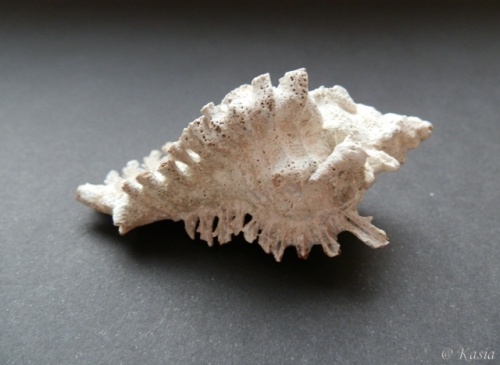



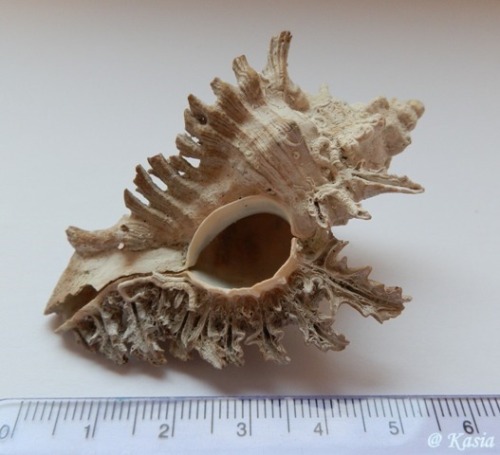




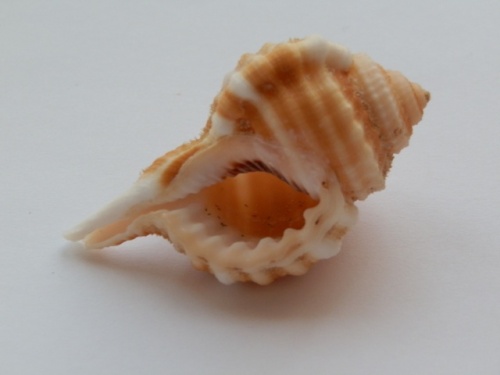
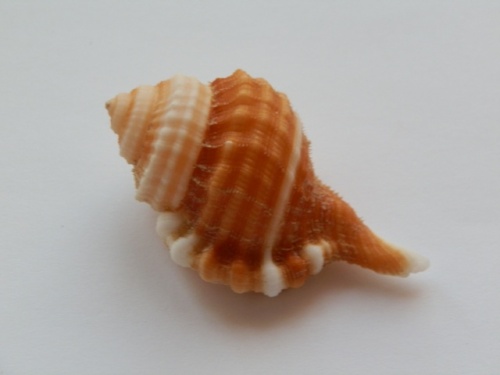
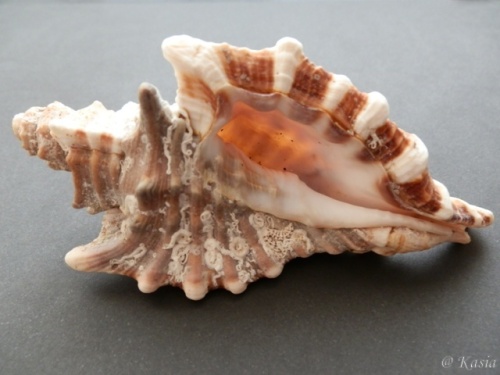















I really enjoyed this information. Most weeks I go to the beach in Nassau as I live close. Do you identify and value shells? And if not, who/where can I contact? Would love to sell some.
LikeLike
Hi Erica, it’s great that you love shell collecting. However while this is fine in a personal basis, by and large collecting and selling on any scale is discouraged. There are guidelines about this, and indeed some shells / beaches may have protected status. I don’t do valuations, and in fact the overwhelming majority of shells have only nominal (if any) value. I tend to suggest that people enjoy them for what they are, and select some for the home, family or friends. You could try painting some as presents!
As for ID there are plenty of online resources and guides, There are bound to be fold out guides in Nassau shops – even (I think) in the airport!
LikeLike
terrific blog !
LikeLike
Thanks! Glad you enjoyed it. RH
LikeLike
Many Amazing Shells..and helpful Information-You take alot of time to help people see and understand with your photos and FACTS…i know where to go when i Have a question about shells… One day I was walking on the beach before work and i was looking at all the broken shells, I was picking them up because they were so beautiful in my hand I saw a piece of artwork. I started collecting shells from Cocoa Beach, Melbourne Beach, Satellite Beach went to sanabel Island, Jupiter and I bought Mirrors and made shell mirrors, They came out nice. I don’t know how to attach a photo here but on my blog one day I will post some photos. I named my project Broken and beautiful, made me think of people starting out fine yet being washed away, or thrown through the waves of life and our lives are diffrent pieces of broken beautiful facts, stories ,adventures, etc. I feel put back together with God’s love we all are a masterpiece. Just my thought. Really enjoy your posts !!! and great photos !!! Have a great day !!! night !! Looking forward to seeing more and learning more from you. Thankful I found your blog. You Inspire me- to write more. I did here lol !!
LikeLike
Hi Holly, sorry to take so long to reply to your 3 kind comments. I’m so pleased you like the shell page. I need to get some more shells to photograph and post about – I hope to be able to collect some new sorts in March. It sounds as though you have been to some excellent places for shelling, and I like the sound of your mirrors. Beaches are such great places for inspiration – I think driftwood frames can look very good. Thanks for all your kind comments, glad you enjoy visiting Rolling Harbour. All the best, RH
LikeLike
Wonderful,photos and info. I am a shell collector for years from Nassau and Abaco Bahamas…..
LikeLike
Thanks for this, so glad you enjoyed the shell page. I wish there was more, but when we are on Abaco there’s so much to do in a short time that shells don’t get enough of a look in. Do you photograph your shells? Do you have wentletraps in your collection? Those are shells I’d like to feature! RH (PS I’ve sent a friend request for my RH FB page)
LikeLike
A wonderful collection of photos and descriptions of a variety of beautiful sea shells.
Thank you for posting all this information for others to enjoy.
Yolanda M. Oakville, Ontario, Canada
LikeLike
Thank you for your kind comment and for calling in at Rolling Harbour. RH
LikeLike
Hello l have enjoyed your site, but my question on sea biscut l have is unusual ,can’t seem to find it in any shell book l have here in abaco, so l hope you can help me identify it ……Its 8-9inch long ,5inch across looks like a a huge sea biscuts but not flat its oblong…..I was told its a ladder jack ,have you ever heard of this???? mirella / abaco ,mash harbour…thank you
LikeLike
Mirella, I’ve never heard of a ladder jack (except as a work tool) – but might it be a sea pancake or (maybe more likely) sea gopher? I’ve uploaded an image so you can see an image: https://rollingharbour.files.wordpress.com/2012/02/sd-sea-gopher.jpg
Look at the large oblong size and shape in relation to the sand dollars. Anything like yours? RH
LikeLike